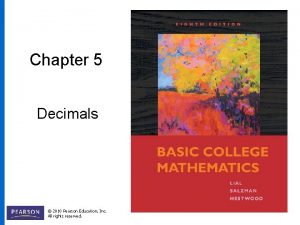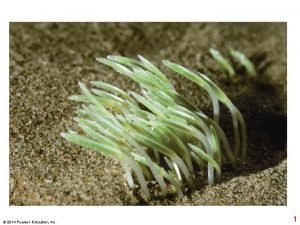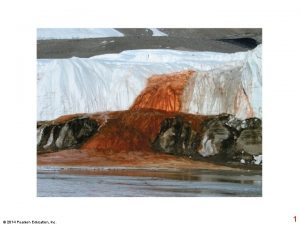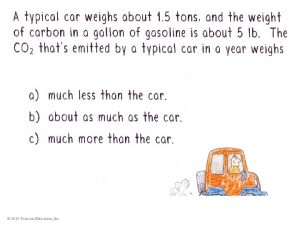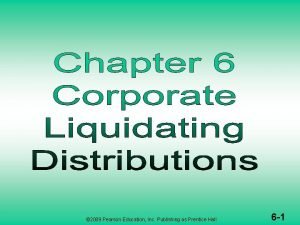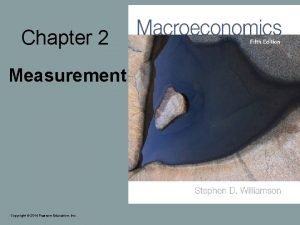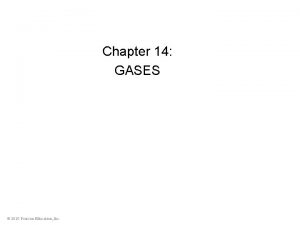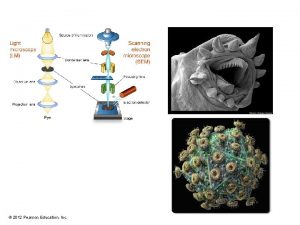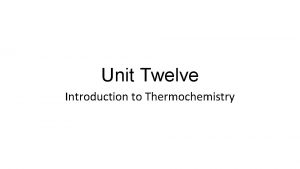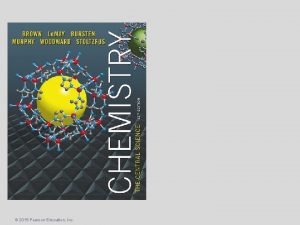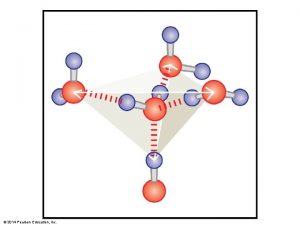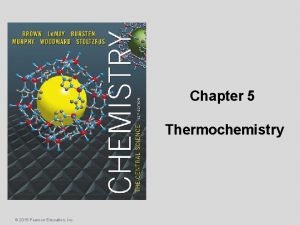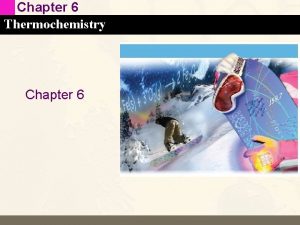Chapter 5 Thermochemistry 2012 Pearson Education Inc Dr





















































![Hess’s Law Hess’s law states that “[i]f a reaction is carried out in a Hess’s Law Hess’s law states that “[i]f a reaction is carried out in a](https://slidetodoc.com/presentation_image_h/d1f09fc34f53d94cbf0e71eed18139b8/image-54.jpg)






















- Slides: 76

Chapter 5 Thermochemistry © 2012 Pearson Education, Inc. Dr. Subhash C Goel South GA State College Douglas, GA

Nature of Energy • Even though Chemistry is the study of • • matter, energy affects matter. Energy is anything that has the capacity to do work. Work is a force acting over a distance. üenergy = work = force × distance • Energy can be exchanged between objects through contact. ücollisions Tro, Principles of Chemistry: A Molecular Approach 2

Energy, Heat, and Work • You can think of energy as a quantity an object can possess. üor collection of objects • You can think of heat and work as the two different ways that an object can exchange energy with other objects. üeither out of it, or into it Tro, Principles of Chemistry: A Molecular Approach 3

Energy – Chemists define work as directed energy change resulting from a process. – Energy used to cause the temperature of an object to rise is called heat. Thermochemistry © 2012 Pearson Education, Inc.

Energy • Chemists are interested in different kind of energies: 1. Kinetic Energy 2. Radiant Energy 3. Thermal Energy 4. Chemical Energy 5. Potential Energy Thermochemistry © 2012 Pearson Education, Inc.

Kinetic Energy, EK The energy associated with an object by virtue of its motion. m = mass (kg) v = velocity (m/s) Thermal energy is a kind of kinetic energy. Copyright © Cengage Learning. All rights reserved. 6|6

Radiant Energy • It’s solar energy and comes from sun • It’s the primary Energy source for Earth • It heats the atmosphere and surface of earth • Vegetation through photosynthesis Thermochemistry © 2012 Pearson Education, Inc.

Thermal Energy • It’s the energy that is associated with the random motion of atoms and molecules • Temperature is not the measurement of thermal energy • It’s depend on quantity: Extensive property Thermochemistry © 2012 Pearson Education, Inc.

Heat • Heat and Thermal energy are different • Heat is the transfer of thermal energy between two bodies that are at the different temperatures. • Heat flows from warmer objects to cooler objects. • Thermochemistry is the study of heat changes in chemical reactions. Thermochemistry © 2012 Pearson Education, Inc.

Chemical Energy • It is stored within the structural units of chemical substances. (It’s a kind of potential energy) • When substances participate in chemical reactions chemical energy is released, stored, or converted to other form of energies. Thermochemistry © 2012 Pearson Education, Inc.

Potential Energy, EP The energy an object has by virtue of its position in a field of force, such as gravitaitonal, electric or magnetic field. Gravitational potential energy is given by the equation m = mass (kg) g = gravitational constant (9. 80 m/s 2) h = height (m) Copyright © Cengage Learning. All rights reserved. 6 | 11

The SI unit of energy is the joule, J, pronounced “jewel. ” The calorie is a non-SI unit of energy commonly used by chemists. It was originally defined as the amount of energy required to raise the temperature of one gram of water by one degree Celsius. The exact definition is given by the equation: Copyright © Cengage Learning. All rights reserved. 6 | 12

? A person weighing 75. 0 kg (165 lbs) runs a course at 1. 78 m/s (4. 00 mph). What is the person’s kinetic energy? m = 75. 0 kg v = 1. 78 m/s Copyright © Cengage Learning. All rights reserved. EK = ½ mv 2 6 | 13

Thermodynamic System The substance under study in which a change occurs is called thermodynamic system (or just system). Thermodynamic Surroundings Everything else in the vicinity is called thermodynamic surroundings (or just the surroundings). Copyright © Cengage Learning. All rights reserved. 6 | 14

THREE TYPES OF SYSTEM 1. Open System: e. g. water in an open container. Can exchange mass and heat with surroundings(in the form of heat). 2. Closed System: e. g. water in a closed containers. Only transfer of energy, not mass. 3. Isolated System: e. g. water in a insulted container. No transfer of mass or energy Thermochemistry

Exchanging Energy • Energy cannot be created or destroyed. • Energy can be exchanged between objects. • Energy can also be transformed from one form to another. ü heat → light → sound Tro, Principles of Chemistry: A Molecular Approach 16

The First Law of Thermodynamics— Law of Conservation of Energy • When energy is exchanged between objects or • • transformed into another form, all the energy is still there. The total amount of energy in the universe before the change has to be equal to the total amount of energy in the universe after. You can, therefore, never design a system that will continue to produce energy without some source of energy. Tro, Principles of Chemistry: A Molecular Approach 17

Internal Energy • The internal energy is the total amount of kinetic • and potential energy a system possesses. The change in the internal energy of a system depends only on the amount of energy in the system at the beginning and end. ü A state function is a mathematical function whose result depends only on the initial and final conditions, not on the process used. ü E = Efinal – Einitial ü Ereaction = Eproducts – Ereactants Tro, Principles of Chemistry: A Molecular Approach 18

State Functions • State Functions are the properties that are determined by the state of system, regardless of how that condition was achieved. • Energy, pressure, volume, and temperature are the examples of State Functions. Thermochemistry.

State Functions • However, we do know that the internal energy of a system is independent of the path by which the system achieved that state. – In the system depicted in this figure , the water could have reached room temperature from either direction. Thermochemistry © 2012 Pearson Education, Inc.

State Functions • Therefore, internal energy is a state function. • It depends only on the present state of the system, not on the path by which the system arrived at that state. • And so, E depends only on Einitial and Efinal. Thermochemistry © 2012 Pearson Education, Inc.

Energy Diagrams Internal Energy • Energy diagrams are a “graphical” way of showing the direction of energy flow during a process. Internal Energy • If the final condition has a larger amount of internal energy than the initial condition, the change in the internal energy will be +. • If the final condition has a smaller amount of internal energy than the initial condition, the change in the internal energy will be –. Tro, Principles of Chemistry: A Molecular Approach 22 final initial energy added E = + initial final energy removed E = –

Energy Flow • When energy flows out of a • • • system, it must all flow into the surroundings. When energy flows out of a system, Esystem is –. When energy flows into the surroundings, Esurroundings is +. therefore: – Esystem = Esurroundings Tro, Principles of Chemistry: A Molecular Approach 23 Surroundings E + System E –

Energy Flow • When energy flows into a • • • system, it must all come from the surroundings. When energy flows into a system, Esystem is +. When energy flows out of the surroundings, Esurroundings is –. therefore: Esystem = – Esurroundings Tro, Principles of Chemistry: A Molecular Approach 24 Surroundings E – System E +

Energy Exchange • Energy is exchanged between the system and surroundings through heat and work. ü q = heat (thermal) energy ü w = work energy ü q and w are NOT state functions; their value depends on the process. DE = q + w Tro, Principles of Chemistry: A Molecular Approach 25

Energy Exchange • Energy is exchanged between the system and surroundings through either heat exchange or work being done. Tro, Principles of Chemistry: A Molecular Approach 26

Endothermic Process A chemical reaction or process in which heat is absorbed by the system (q is positive). The reaction vessel will feel cool. Exothermic Process A chemical reaction or process in which heat is evolved by the system (q is negative). The reaction vessel will feel warm. Copyright © Cengage Learning. All rights reserved. 6 | 27

In an endothermic reaction: The reaction vessel cools. Heat is absorbed. Energy is added to the system. q is positive. In an exothermic reaction: The reaction vessel warms. Heat is evolved. Energy is subtracted from the system. q is negative. Copyright © Cengage Learning. All rights reserved. 6 | 28

Endothermic and Exothermic Reactions Examples: • Chemical heat packs contain iron filings that are oxidized in an exothermic reaction. Your hands get warm because the released heat of the reaction is absorbed by your hands. • Chemical cold packs contain NH 4 NO 3 that dissolves in water in an endothermic process. Your hands get cold because they are giving away your heat to the reaction. Tro, Principles of Chemistry: A Molecular Approach 29

Pressure–Volume Work • PV work is work that is the result of a volume • • change against an external pressure. When gases expand, V is +, but the system is doing work on the surroundings, so wgas is –. As long as the external pressure is kept constant, –work = external pressure × change in volume w = –PDV ü To convert the units to joules, use 101. 3 J = 1 atm∙L. Tro, Principles of Chemistry: A Molecular Approach 30

Enthalpy • If a process takes place at constant pressure (as the majority of processes we study do) and the only work done is this pressure–volume work, we can account for heat flow during the process by measuring the enthalpy of the system. • Enthalpy is the internal energy plus the product of pressure and volume: H = E + PV © 2012 Pearson Education, Inc. Thermochemistry

Enthalpy • When the system changes at constant pressure, the change in enthalpy, H, is H = (E + PV) • This can be written H = E + P V Thermochemistry © 2012 Pearson Education, Inc.

Enthalpy • Since E = q + w and w = −P V, we can substitute these into the enthalpy expression: H = E + P V H = (q + w) − w H = q • So, at constant pressure, the change in enthalpy is the heat gained or lost. Thermochemistry © 2012 Pearson Education, Inc.

Enthalpy of Reaction The change in enthalpy, H, is the enthalpy of the products minus the enthalpy of the reactants: H = Hproducts − Hreactants Thermochemistry © 2012 Pearson Education, Inc.

Enthalpy of Reaction This quantity, H, is called the enthalpy of reaction, or the heat of reaction. Thermochemistry © 2012 Pearson Education, Inc.

The Truth about Enthalpy 1. Enthalpy is an extensive property. 2. H for a reaction in the forward direction is equal in size, but opposite in sign, to H for the reverse reaction. 3. H for a reaction depends on the state of the products and the state of the reactants. Thermochemistry © 2012 Pearson Education, Inc.

Sample Exercise 5. 3 Determining the Sign of H Indicate the sign of the enthalpy change, H, in these processes carried out under atmospheric pressure and indicate whether each process is endothermic or exothermic: (a) An ice cube melts; (b) 1 g of butane (C 4 H 10) is combusted in sufficient oxygen to give complete combustion to CO 2 and H 2 O. Solution Analyze Our goal is to determine whether H is positive or negative for each process. Because each process occurs at constant pressure, the enthalpy change equals the quantity of heat absorbed or released, H = q. P. Plan We must predict whether heat is absorbed or released by the system in each process. Processes in which heat is absorbed are endothermic and have a positive sign for H; those in which heat is released are exothermic and have a negative sign for H. Solve In (a) the water that makes up the ice cube is the system. The ice cube absorbs heat from the surroundings as it melts, so H is positive and the process is endothermic. In (b) the system is the 1 g of butane and the oxygen required to combust it. The combustion of butane in oxygen gives off heat, so H is negative and the process is exothermic. Chemistry, The Central Science, 12 th Edition Theodore L. Brown; H. Eugene Le. May, Jr. ; Bruce E. Bursten; Catherine J. Murphy; and Patrick Woodward © 2012 Pearson Education, Inc.

Sample Exercise 5. 4 Relating H to Quantities of Reactants and Products How much heat is released when 4. 50 g of methane gas is burned in a constant-pressure system? (Use the information given in Equation 5. 18. ) Solution Analyze Our goal is to use a thermochemical equation to calculate the heat produced when a specific amount of methane gas is combusted. According to Equation 5. 18, 890 k. J is released by the system when 1 mol CH 4 is burned at constant pressure. Plan Equation 5. 18 provides us with a stoichiometric conversion factor: (1 mol CH 4 = 890 k. J). Thus, we can convert moles of CH 4 to k. J of energy. First, however, we must convert grams of CH 4 to moles of CH 4. Thus, the conversion sequence is grams CH 4 (given) → moles CH 4 → k. J (unknown to be found). Solve By adding the atomic weights of C and 4 H, we have 1 mol CH 4 = 16. 0 CH 4. We can use the appropriate conversion factors to convert grams of CH 4 to moles of CH 4 to kilojoules: The negative sign indicates that the system released 250 k. J into the surroundings. Chemistry, The Central Science, 12 th Edition Theodore L. Brown; H. Eugene Le. May, Jr. ; Bruce E. Bursten; Catherine J. Murphy; and Patrick Woodward © 2012 Pearson Education, Inc.

Calorimetry Since we cannot know the exact enthalpy of the reactants and products, we measure H through calorimetry, the measurement of heat flow. Thermochemistry © 2012 Pearson Education, Inc.

Quantity of Heat Energy Absorbed Heat Capacity • When a system absorbs heat, its temperature increases. • The increase in temperature is directly proportional to the • amount of heat absorbed. The proportionality constant is called the heat capacity, C. ü Units of C are J/°C or J/K. • q = C × DT The heat capacity of an object depends on its mass. ü 200 g of water requires twice as much heat to raise its temperature by 1 °C as does 100 g of water. • The heat capacity of an object depends on the type of material. ü 1000 J of heat energy will raise the temperature of 100 g of sand 12 °C, but only raise the temperature of 100 g of water by 2. 4 °C. Tro, Principles of Chemistry: A Molecular Approach 40

Specific Heat Capacity • measure of a substance’s intrinsic • ability to absorb heat The specific heat capacity is the amount of heat energy required to raise the temperature of one gram of a substance 1 °C. ü Cs ü units are J/(g∙°C) • The molar heat capacity is the amount of heat energy required to raise the temperature of one mole of a substance 1 °C. Tro, Principles of Chemistry: A Molecular Approach 41

Quantifying Heat Energy • The heat capacity of an object is proportional to its • mass and the specific heat of the material. So we can calculate the quantity of heat absorbed by an object if we know the mass, the specific heat, and the temperature change of the object. heat = (mass) × (specific heat capacity) × (temp. change) q = (m) × (Cs) × (DT) Tro, Principles of Chemistry: A Molecular Approach 42

Heat Capacity and Specific Heat Specific heat, then, is heat transferred Specific heat = mass temperature change q Cs = m T Thermochemistry © 2012 Pearson Education, Inc.

? A piece of zinc weighing 35. 8 g was heated from 20. 00°C to 28. 00°C. How much heat was required? The specific heat of zinc is 0. 388 J/(g°C). m = 35. 8 g s = 0. 388 J/(g°C) t = 28. 00°C – 20. 00°C = 8. 00°C q = m Cs q = 111 J (3 significant figures) Copyright © Cengage Learning. All rights reserved. 6 | 44

Sample Exercise 5. 5 Relating Heat, Temperature Change, and Heat Capacity (a) How much heat is needed to warm 250 g of water (about 1 cup) from 22 C (about room temperature) to 98 C (near its boiling point)? (b) What is the molar heat capacity of water? Solution Analyze In part (a) we must find the quantity of heat (q) needed to warm the water, given the mass of water (m), its temperature change ( T), and its specific heat (Cs). In part (b) we must calculate the molar heat capacity (heat capacity per mole, Cm) of water from its specific heat (heat capacity per gram). Plan (a) Given Cs, m, and T, we can calculate the quantity of heat, q, using Equation 5. 22. (b) We can use the molar mass of water and dimensional analysis to convert from heat capacity per gram to heat capacity per mole. Solve (a) The water undergoes a temperature change of Using Equation 5. 22, we have (b) The molar heat capacity is the heat capacity of one mole of substance. Using the atomic weights of hydrogen and oxygen, we have T = 98 C – 22 C = 76 K q = Cs m T = (4. 18 J/g–K)(250 g)(76 K) = 7. 9 104 J 1 mol H 2 O = 18. 0 g H 2 O From the specific heat given in part (a), we have Chemistry, The Central Science, 12 th Edition Theodore L. Brown; H. Eugene Le. May, Jr. ; Bruce E. Bursten; Catherine J. Murphy; and Patrick Woodward © 2012 Pearson Education, Inc.

Constant Pressure Calorimetry By carrying out a reaction in aqueous solution in a simple calorimeter such as this one, one can indirectly measure the heat change for the system by measuring the heat change for the water in the calorimeter. Thermochemistry © 2012 Pearson Education, Inc.

Constant Pressure Calorimetry Because the specific heat for water is well known (4. 184 J/g-K), we can measure H for the reaction with this equation: q = m Cs T Thermochemistry © 2012 Pearson Education, Inc.

Sample Exercise 5. 6 Measuring H Using a Coffee-Cup Calorimeter When a student mixes 50 m. L of 1. 0 M HCl and 50 m. L of a negligible quantity of heat, that the total volume of the 1. 0 M Na. OH in a coffee-cup calorimeter, the temperature solution is 100 m. L, that its density is of the resultant solution increases from 21. 0 C to 27. 5 C. 1. 0 g/m. L, and that its specific heat is 4. 18 J/g–K. Calculate the enthalpy change for the reaction in kj/mol HCl, assuming that the calorimeter loses only Solution Analyze Mixing solutions of HCl and Na. OH results in an acid–base reaction: HCl(aq) + Na. OH(aq) H 2 O(l) + Na. Cl(aq) We need to calculate the heat produced per mole of HCl, given the temperature increase of the solution, the number of moles of HCl and Na. OH involved, and the density and specific heat of the solution. Plan The total heat produced can be calculated using Equation 5. 23. The number of moles of HCl consumed in the reaction must be calculated from the volume and molarity of this substance, and this amount is then used to determine the heat produced per mol HCl. Solve Because the total volume of the solution is 100 m. L, its mass is The temperature change is Using Equation 5. 23, we have (100 m. L)(1. 0 g/m. L) = 100 g T = 27. 5 C – 21. 0 C = 6. 5 K qrxn = –Cs m T = –(4. 18 J/g–K)(100 g)(6. 5 K) = – 2. 7 103 J = – 2. 7 k. J Chemistry, The Central Science, 12 th Edition Theodore L. Brown; H. Eugene Le. May, Jr. ; Bruce E. Bursten; Catherine J. Murphy; and Patrick Woodward © 2012 Pearson Education, Inc.

Sample Exercise 5. 6 Measuring H Using a Coffee-Cup Calorimeter Continued Because the process occurs at constant pressure, H = q. P = – 2. 7 k. J To express the enthalpy change on a molar basis, we use the fact that the number of moles of HCl is given by the product of the volume (50 m. L = 0. 050 L) and concentration (1. 0 M = 1. 0 mol/L) of the HCl solution: (0. 050 L)(1. 0 mol/L) = 0. 050 mol Thus, the enthalpy change per mole of HCl is H = – 2. 7 k. J/0. 050 mol = – 54 k. J/mol Check H is negative (exothermic), which is expected for the reaction of an acid with a base and evidenced by the fact that the reaction causes the temperature of the solution to increase. The magnitude of the molar enthalpy change seems reasonable. Chemistry, The Central Science, 12 th Edition Theodore L. Brown; H. Eugene Le. May, Jr. ; Bruce E. Bursten; Catherine J. Murphy; and Patrick Woodward © 2012 Pearson Education, Inc.

Bomb Calorimetry • Reactions can be carried out in a sealed “bomb” such as this one. • The heat absorbed (or released) by the water is a very good approximation of the enthalpy change for the reaction. Thermochemistry © 2012 Pearson Education, Inc.

Bomb Calorimetry • Because the volume in the bomb calorimeter is constant, what is measured is really the change in internal energy, E, not H. • For most reactions, the difference is very small. Thermochemistry © 2012 Pearson Education, Inc.

Sample Exercise 5. 7 Measuring qrxn Using a Bomb Calorimeter The combustion of methylhydrazine (CH 6 N 2), a liquid from 25. 00 C to 39. 50 C. In a separate experiment the rocket fuel, produces N 2(g), CO 2(g), and H 2 O(l): heat capacity of the calorimeter is measured to be 7. 794 2 CH 6 N 2(l) + 5 O 2(g) 2 N 2(g) + 2 CO 2(g) + 6 H 2 O(l) k. J/ C. Calculate the heat of reaction for the combustion of a mole of CH 6 N 2. When 4. 00 g of methylhydrazine is combusted in a bomb calorimeter, the temperature of the calorimeter increases Solution Analyze We are given a temperature change and the total heat capacity of the calorimeter. We are also given the amount of reactant combusted. Our goal is to calculate the enthalpy change per mole for combustion of the reactant. Plan We will first calculate the heat evolved for the combustion of the 4. 00 -g sample. We will then convert this heat to a molar quantity. Solve For combustion of the 4. 00 -g sample of methylhydrazine, the temperature change of the calorimeter is T = (39. 50 C – 25. 00 C) = 14. 50 C We can use T and the value for Ccal to calculate the heat of reaction (Equation 5. 24): qrxn = –Ccal T = –(7. 794 k. J/ C)(14. 50 C) = – 113. 0 k. J We can readily convert this value to the heat of reaction for a mole of CH 6 N 2: Chemistry, The Central Science, 12 th Edition Theodore L. Brown; H. Eugene Le. May, Jr. ; Bruce E. Bursten; Catherine J. Murphy; and Patrick Woodward © 2012 Pearson Education, Inc.

Hess’s Law • H is well known for many reactions, and it is inconvenient to measure H for every reaction in which we are interested. • However, we can estimate H using published H values and the properties of enthalpy. Thermochemistry © 2012 Pearson Education, Inc.
![Hesss Law Hesss law states that if a reaction is carried out in a Hess’s Law Hess’s law states that “[i]f a reaction is carried out in a](https://slidetodoc.com/presentation_image_h/d1f09fc34f53d94cbf0e71eed18139b8/image-54.jpg)
Hess’s Law Hess’s law states that “[i]f a reaction is carried out in a series of steps, H for the overall reaction will be equal to the sum of the enthalpy changes for the individual steps. ” Thermochemistry © 2012 Pearson Education, Inc.

Hess’s Law Because H is a state function, the total enthalpy change depends only on the initial state of the reactants and the final state of the products. Thermochemistry © 2012 Pearson Education, Inc.

Sample Exercise 5. 8 Using Hess’s Law to Calculate H The enthalpy of reaction for the combustion of C to CO 2 is – 393. 5 k. J/mol C, and the enthalpy for the combustion of CO to CO 2 is – 283. 0 k. J/mol C: 1. 2. Using these data, calculate the enthalpy for the combustion of C to CO: 3. Solution Analyze We are given two thermochemical equations, and our goal is to combine them in such a way as to obtain the third equation and its enthalpy change. Plan We will use Hess’s law. In doing so, we first note the numbers of moles of substances among the reactants and products in the target equation, (3). We then manipulate equations (1) and (2) to give the same number of moles of these substances, so that when the resulting equations are added, we obtain the target equation. At the same time, we keep track of the enthalpy changes, which we add. Chemistry, The Central Science, 12 th Edition Theodore L. Brown; H. Eugene Le. May, Jr. ; Bruce E. Bursten; Catherine J. Murphy; and Patrick Woodward © 2012 Pearson Education, Inc.

Sample Exercise 5. 8 Using Hess’s Law to Calculate H Continued Solve To use equations (1) and (2), we arrange them so that C(s) is on the reactant side and CO(g) is on the product side of the arrow, as in the target reaction, equation (3). Because equation (1) has C(s) as a reactant, we can use that equation just as it is. We need to turn equation (2) around, however, so that CO(g) is a product. Remember that when reactions are turned around, the sign of H is reversed. We arrange the two equations so that they can be added to give the desired equation: When we add the two equations, CO 2(g) appears on both sides of the arrow and therefore cancels out. Likewise, ½ 02 (g) is eliminated from each side. Chemistry, The Central Science, 12 th Edition Theodore L. Brown; H. Eugene Le. May, Jr. ; Bruce E. Bursten; Catherine J. Murphy; and Patrick Woodward © 2012 Pearson Education, Inc.

Sample Exercise 5. 9 Using Three Equations with Hess’s Law to Calculate H for the reaction 2 C(s) + H 2(g) C 2 H 2(g) given the following chemical equations and their respective enthalpy changes: Solution Analyze We are given a chemical equation and asked to calculate its H using three chemical equations and their associated enthalpy changes. Plan We will use Hess’s law, summing the three equations or their reverses and multiplying each by an appropriate coefficient so that they add to give the net equation for the reaction of interest. At the same time, we keep track of the H values, reversing their signs if the reactions are reversed and multiplying them by whatever coefficient is employed in the equation. Chemistry, The Central Science, 12 th Edition Theodore L. Brown; H. Eugene Le. May, Jr. ; Bruce E. Bursten; Catherine J. Murphy; and Patrick Woodward © 2012 Pearson Education, Inc.

Sample Exercise 5. 9 Using Three Equations with Hess’s Law to Calculate H Continued Solve Because the target equation has C 2 H 2 as a product, we turn the first equation around; the sign of H is therefore changed. The desired equation has 2 C(s) as a reactant, so we multiply the second equation and its H by 2. Because the target equation has H 2 as a reactant, we keep the third equation as it is. We then add the three equations and their enthalpy changes in accordance with Hess’s law: When the equations are added, there are 2 CO 2, 5/2 O 2, and H 2 O on both sides of the arrow. These are canceled in writing the net equation. Chemistry, The Central Science, 12 th Edition Theodore L. Brown; H. Eugene Le. May, Jr. ; Bruce E. Bursten; Catherine J. Murphy; and Patrick Woodward © 2012 Pearson Education, Inc.

Enthalpies of Formation An enthalpy of formation, Hf, is defined as the enthalpy change for the reaction in which a compound is made from its constituent elements in their elemental forms. Thermochemistry © 2012 Pearson Education, Inc.

Standard Enthalpies of Formation Standard enthalpies of formation, Hf°, are measured under standard conditions (25 °C and 1. 00 atm pressure). Thermochemistry © 2012 Pearson Education, Inc.

Calculation of H C 3 H 8(g) + 5 O 2(g) 3 CO 2(g) + 4 H 2 O(l) • Imagine this as occurring in three steps: C 3 H 8(g) 3 C(graphite) + 4 H 2(g) Thermochemistry © 2012 Pearson Education, Inc.

Calculation of H C 3 H 8(g) + 5 O 2(g) 3 CO 2(g) + 4 H 2 O(l) • Imagine this as occurring in three steps: C 3 H 8(g) 3 C(graphite) + 4 H 2(g) 3 C(graphite) + 3 O 2(g) 3 CO 2(g) Thermochemistry © 2012 Pearson Education, Inc.

Calculation of H C 3 H 8(g) + 5 O 2(g) 3 CO 2(g) + 4 H 2 O(l) • Imagine this as occurring in three steps: C 3 H 8(g) 3 C(graphite) + 4 H 2(g) 3 C(graphite) + 3 O 2(g) 3 CO 2(g) 4 H 2(g) + 2 O 2(g) 4 H 2 O(l) Thermochemistry © 2012 Pearson Education, Inc.

Calculation of H C 3 H 8(g) + 5 O 2(g) 3 CO 2(g) + 4 H 2 O(l) • The sum of these equations is C 3 H 8(g) 3 C(graphite) + 4 H 2(g) 3 C(graphite) + 3 O 2(g) 3 CO 2(g) 4 H 2(g) + 2 O 2(g) 4 H 2 O(l) C 3 H 8(g) + 5 O 2(g) 3 CO 2(g) + 4 H 2 O(l) Thermochemistry © 2012 Pearson Education, Inc.

Calculation of H We can use Hess’s law in this way: H = n Hf, products – m Hf°, reactants where n and m are the stoichiometric coefficients. Thermochemistry © 2012 Pearson Education, Inc.

Calculation of H C 3 H 8(g) + 5 O 2(g) 3 CO 2(g) + 4 H 2 O(l) H = [3(− 393. 5 k. J) + 4(− 285. 8 k. J)] – [1(− 103. 85 k. J) + 5(0 k. J)] = [(− 1180. 5 k. J) + (− 1143. 2 k. J)] – [(− 103. 85 k. J) + (0 k. J)] = (− 2323. 7 k. J) – (− 103. 85 k. J) = − 2219. 9 k. J Thermochemistry © 2012 Pearson Education, Inc.

Foods fuels three needs of the body: • They supply substances for the growth and repair of tissue. • They supply substances for the synthesis of compounds used in the regulation processes. • They supply energy. Foods do this by a combustion process. Copyright © Cengage Learning. All rights reserved. 6 | 68

For glucose, a carbohydrate: C 6 H 12 O 6(s) + 6 O 2(g) 6 CO 2(g) + 6 H 2 O(l); Hf° = – 2803 k. J For glycerol trimyristate, a fat: C 45 H 86 O 6(s) + 127/2 O 2(g) 45 CO 2(g) + 43 H 2 O(l); Hf°= – 27, 820 k. J The average value for carbohydrates is 4. 0 kcal/g and for fats is 9. 0 kcal/g. Copyright © Cengage Learning. All rights reserved. 6 | 69

Energy in Foods Most of the fuel in the food we eat comes from carbohydrates and fats. Thermochemistry © 2012 Pearson Education, Inc.

Fossil fuels originated millions of years ago when aquatic plants and animals were buried and compressed by layers of sediment at the bottoms of swamps and seas. Over time this organic matter was converted by bacterial decay and pressure to petroleum (oil), gas, and coal. Copyright © Cengage Learning. All rights reserved. 6 | 71

Coal, which accounts for 22. 9% of total U. S. energy consumption, varies in terms of the amount of carbon it contains and so varies in terms of the amount of energy it produces in combustion. Anthracite (hard coal) was laid down as long as 250 million years ago and can contain as much as 80% carbon. Bituminous coal, a younger variety, contains between 45% and 65% carbon. Copyright © Cengage Learning. All rights reserved. 6 | 72

Natural gas, which accounts for 22. 7% of total U. S. energy consumption, is convenient because it is fluid and can be easily transported. Purified natural gas is primarily methane, CH 4, plus small amounts of ethane, C 2 H 6; propane, C 3 H 8; and butane, C 4 H 10. Petroleum is a mixture of compounds. Gasoline, which is obtained from petroleum, is a mixture of hydrocarbons (compounds of carbon and hydrogen). Copyright © Cengage Learning. All rights reserved. 6 | 73

The main issue with natural gas and petroleum is their relatively short supply. It has been estimated that petroleum deposits will be 80% depleted by 2030. Natural gas deposits may be depleted even sooner. Coal deposits, however, are expected to last for several more centuries. This has led to the development of commercial methods for converting coal to the more easily handled liquid and gaseous fuels. Copyright © Cengage Learning. All rights reserved. 6 | 74

Coal gasification is one way. Steam is passed over hot coal: C(s) + H 2 O(g) CO(g) + H 2(g) The mixture containing carbon monoxide can be converted by various methods into useful products. The mixture of carbon monoxide and hydrogen can be converted by various methods into useful products such as methane, CH 4. CO(g) + 3 H 2(g) CH 4(g) + H 2 O(g) Copyright © Cengage Learning. All rights reserved. 6 | 75

Energy in Fuels The vast majority of the energy consumed in this country comes from fossil fuels. Thermochemistry © 2012 Pearson Education, Inc.
 Pearson education 2012
Pearson education 2012 2012 pearson education inc
2012 pearson education inc 2012 pearson education inc
2012 pearson education inc 2012 pearson education inc
2012 pearson education inc Anterior posterior ventral dorsal
Anterior posterior ventral dorsal Pearson education inc. 2012
Pearson education inc. 2012 Pearson education inc. 2012
Pearson education inc. 2012 2012 pearson education inc anatomy and physiology
2012 pearson education inc anatomy and physiology Pearson mbo
Pearson mbo 2012 pearson education inc
2012 pearson education inc Pearson education 2012
Pearson education 2012 2012 pearson education inc
2012 pearson education inc Pearson education inc. 2012
Pearson education inc. 2012 2012 pearson education inc
2012 pearson education inc 2012 pearson education inc
2012 pearson education inc 2012 pearson education inc
2012 pearson education inc Pearson education inc publishing as pearson prentice hall
Pearson education inc publishing as pearson prentice hall Pearson education inc all rights reserved
Pearson education inc all rights reserved Pearson education inc publishing as pearson prentice hall
Pearson education inc publishing as pearson prentice hall Pearson education inc publishing as pearson prentice hall
Pearson education inc publishing as pearson prentice hall Pearson education inc publishing as pearson prentice hall
Pearson education inc publishing as pearson prentice hall Copyright 2008
Copyright 2008 Pearson education 2012
Pearson education 2012 2018 pearson education inc
2018 pearson education inc Pearson education limited 2017
Pearson education limited 2017 Copyright by pearson education inc. answers
Copyright by pearson education inc. answers 2017 pearson education inc
2017 pearson education inc 2017 pearson education inc
2017 pearson education inc 2017 pearson education inc
2017 pearson education inc 2017 pearson education inc
2017 pearson education inc 2016 pearson education inc
2016 pearson education inc 2015 pearson education inc
2015 pearson education inc 2014 pearson education inc
2014 pearson education inc 2013 pearson education inc
2013 pearson education inc 2013 pearson education inc
2013 pearson education inc 2013 pearson education inc
2013 pearson education inc 2013 pearson education inc
2013 pearson education inc 2010 pearson education inc
2010 pearson education inc 2010 pearson education inc
2010 pearson education inc 2009 pearson education inc
2009 pearson education inc 2016 pearson education inc
2016 pearson education inc Decimal in words example
Decimal in words example 2010 pearson education inc
2010 pearson education inc 2014 pearson education inc
2014 pearson education inc 2014 pearson education inc
2014 pearson education inc 2014 pearson education inc
2014 pearson education inc 2014 pearson education inc
2014 pearson education inc 2014 pearson education inc
2014 pearson education inc 2014 pearson education inc
2014 pearson education inc 2014 pearson education inc
2014 pearson education inc 2011 pearson education inc
2011 pearson education inc 2011 pearson education inc
2011 pearson education inc 2011 pearson education inc
2011 pearson education inc 2011 pearson education inc
2011 pearson education inc 2011 pearson education inc
2011 pearson education inc 2011 pearson education inc
2011 pearson education inc 2010 pearson education inc answers
2010 pearson education inc answers 2009 pearson education inc
2009 pearson education inc 2009 pearson education inc
2009 pearson education inc 2016 pearson education inc
2016 pearson education inc 2017 pearson education inc
2017 pearson education inc Pearson education inc 1
Pearson education inc 1 2016 pearson education inc
2016 pearson education inc 2016 pearson education inc
2016 pearson education inc Copyright pearson education inc
Copyright pearson education inc 2014 pearson education inc
2014 pearson education inc 2013 pearson education inc
2013 pearson education inc 2013 pearson education inc
2013 pearson education inc Copyright 2009
Copyright 2009 Copyright 2009 pearson education inc
Copyright 2009 pearson education inc Pearson education
Pearson education 2008 pearson education inc
2008 pearson education inc Copyright 2003 pearson education inc
Copyright 2003 pearson education inc 2010 pearson education inc answers
2010 pearson education inc answers 2014 pearson education inc
2014 pearson education inc 2014 pearson education inc
2014 pearson education inc 2010 pearson education inc answers
2010 pearson education inc answers









































